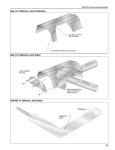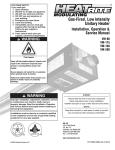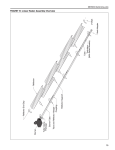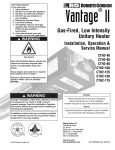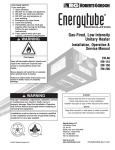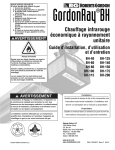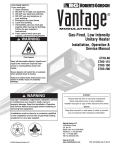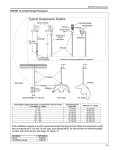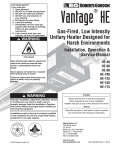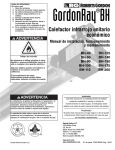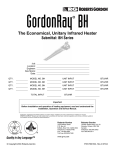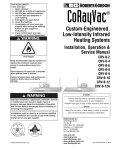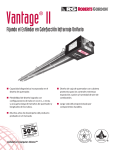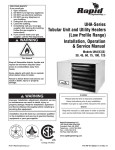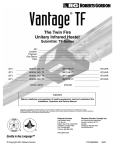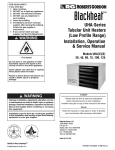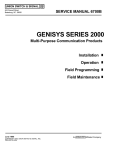Download Manual - Heat-Rite VST - Val-Co
Transcript
FOR YOUR SAFETY If you smell gas: 1. Open windows. 2. DO NOT try to light any appliance. 3. DO NOT use electrical switches. 4. DO NOT use any telephone in your building. 5. Extinguish any open flame. 6. Leave the building. 7. Immediately call your local gas supplier after leaving the building. Follow the gas supplier’s instructions. 8. If you cannot reach your gas supplier, call the Fire Department. WARNING VST Gas-Fired, Low Intensity Unitary Heater Installation, Operation & Service Manual VST-40 VST-60 VST-80 VST-100 VST-125 VST-150 VST-175 Fire Hazard Keep all flammable objects, liquids and vapors the minimum required clearances to combustibles away from heater. Some objects will catch fire or explode when placed close to heater. Failure to follow these instructions can result in death, injury or property damage. Installer WARNING Improper installation, adjustment, alteration, service or maintenance can result in death, injury or property damage. Read the Installation, Operation and Service Manual thoroughly before installing or servicing this equipment. Installation must be done by a contractor qualified in the installation and service of gas-fired heating equipment or your gas supplier. Please take the time to read and understand these instructions prior to any installation. Installer must give a copy of this manual to the owner. Owner Keep this manual in a safe place in order to provide your serviceman with necessary information. Val-Co. 210 E. Main Street P.O. Box 117 Coldwater, OH 45828 USA Telephone: 800.998.2526 Fax: +1.419.678.2200 www.val-co.com © 2013 Roberts-Gordon LLC P/N VST30100NA Rev. F 02/13 TABLE OF CONTENTS SECTION 1: Heater Safety...................................................... 1 1.1 Manpower Requirements ............................................. 1 1.2 Safety Labels and Their Placement ............................. 1 1.3 California Proposition 65 .............................................. 1 SECTION 2: Installer Responsibility ..................................... 4 2.1 Wall Tag ....................................................................... 4 2.2 Brooder Wall Tag ......................................................... 4 2.3 Corrosive Chemicals.................................................... 4 2.4 National Standards and Applicable Codes .................. 5 SECTION 3: Clearances to Combustibles............................. 6 3.1 Required Clearances to Combustibles......................... 6 SECTION 4: National Standards and Applicable Codes ..... 9 4.1 Gas Codes................................................................... 9 4.2 Aircraft Hangars ........................................................... 9 4.3 Public Garages ............................................................ 9 4.4 Electrical ...................................................................... 9 4.5 Venting......................................................................... 9 4.6 High Altitude ................................................................ 9 SECTION 5: Major Components .......................................... 10 5.1 Standard Parts List .................................................... 11 SECTION 6: Heater Installation............................................ 13 6.1 Burner Tube Installation ............................................ 18 6.2 Tube Clamp Package Installation .............................. 18 6.3 Coupling and Tube Assembly.................................... 19 6.4 Turbulator Installation ................................................ 20 6.5 Reflector Installation .................................................. 21 6.6 Burner Installation...................................................... 23 SECTION 7: Optional Heater Accessories .......................... 24 7.1 U-Tube Configuration.................................................. 24 7.2 Elbow Package Configuration..................................... 29 7.3 Reflector Side Extension ............................................ 31 7.4 Lower Clearance Shield Installation ........................... 32 7.5 Two-Foot Decorative Grille Installation ....................... 32 7.6 Protective Grille Installation ........................................ 34 SECTION 8: Venting.............................................................. 35 8.1 Venting....................................................................... 35 8.2 Unvented Operation................................................... 35 8.3 Horizontal Venting...................................................... 36 8.4 Vertical Venting .......................................................... 36 8.5 Unvented Operation Tube Termination ...................... 36 8.6 Length Requirements ................................................ 36 8.7 Horizontal Ventilation 4" (10 cm) Pipe........................ 36 8.8 Vertical Ventilation 4" (10 cm) Pipe ............................ 37 8.9 Common Sidewall Venting ......................................... 37 8.10 Common Vertical Venting ........................................ 38 8.11 Outside Combustion Air Supply ............................... 39 SECTION 9: Gas Piping........................................................ 42 SECTION 10: Wiring.............................................................. 44 10.1 Line Voltage Thermostat Wiring............................... 44 10.2 Low Voltage Thermostat with One Burner ............... 44 10.3 Low Voltage Thermostat Wiring with Multiple Burners..................................................................... 45 10.4 Internal Wiring.......................................................... 45 10.5 Ladder Diagram ....................................................... 46 10.6 Electrical Connection to the Burner ......................... 46 SECTION 11: Operation and Maintenance.......................... 47 11.1 Sequence of Operation ............................................ 47 11.2 To Shut Off Heater.................................................... 47 11.3 To Start Heater ......................................................... 47 11.4 Pre-Season Maintenance and Annual Inspection..... 47 11.5 Maintenance Checklist ............................................. 48 SECTION 12: Troubleshooting............................................. 50 12.1 Honeywell SmartValve® II Troubleshooting .............. 51 12.2 Troubleshooting Flow Chart ..................................... 52 12.3 Manifold Gas Pressure Setting ................................ 54 SECTION 13: Replacement Parts ........................................ 55 SECTION 14: General Specifications .................................. 58 14.1 Material Specifications............................................. 58 14.2 Heater Specifications............................................... 58 14.3 Suspension Specifications....................................... 58 14.4 Controls Specifications ............................................ 58 © 2013 Roberts-Gordon LLC All rights reserved. No part of this work covered by the copyrights herein may be reproduced or copied in any form or by any means - graphic, electronic, or mechanical, including photocopying, recording, taping or information storage and retrieval systems - without the written permission of Roberts-Gordon LLC. Printed in U.S.A. TABLE OF FIGURES Figure 1: Top and Bottom Panel Label Placement .................... 2 Figure 2: Side and Back Panel Label Placement ...................... 3 Figure 3: Standard Reflector ..................................................... 6 Figure 4: One Side Reflector..................................................... 7 Figure 5: Two Side Reflectors ................................................... 7 Figure 6: U-Tube, Standard Reflector........................................ 7 Figure 7: 2-Foot Deco Grille and Protective Grille ..................... 8 Figure 8: Lower Clearance Shield* ........................................... 8 Figure 9: Venting ....................................................................... 8 Figure 10: Major Component Descriptions.............................. 10 Figure 11: Critical Hanger Placement...................................... 14 Figure 12: Linear Heater Assembly Overview ........................ 15 Figure 13: Linear Heater Layout Overview.............................. 16 Figure 14: Linear Heater Layout Overview (Continued) .......... 17 Figure 15: U-Tube Heater Assembly Overview ...................... 25 Figure 16: U-tube reflector kit (optional).................................. 26 Figure 17: U-Tube Heater Layout Overview ........................... 27 Figure 18: U-Tube Heater Layout Overview (Continued) ........ 28 Figure 19: Reflector Joint Detail .............................................. 30 Figure 20: Tube Termination ................................................... 36 Figure 21: Gas Connection with Flexible Gas Hose ............... 43 LIST OF TABLES Table 1: Contents of the Burner Carton ................................. 11 Table 2: Contents of Wide Pattern Core and Wide Pattern Extension Packages ................................................. 11 Table 3: Component Package Guide...................................... 12 SECTION 1: HEATER SAFETY SECTION 1: HEATER SAFETY Your Safety is Important to Us! This symbol is used throughout the manual to notify you of possible fire, electrical or burn hazards. Please pay special attention when reading and following the warnings in these sections. 1.1 Manpower Requirements To prevent personal injury and damage to the heater, two persons will be required for installation. 1.2 Safety Labels and Their Placement Product safety signs or labels should be replaced by Installation, service and annual inspection of heater the product user when they are no longer are legible. must be done by a contractor qualified in the installa- Please contact Val-Co or your VAL-CO independent distributor to obtain replacement signs or labels. See tion and service of gas-fired heating equipment. Page 2, Figure 1 through Page 3, Figure 2. Read this manual carefully before installation, operation or service of this equipment. 1.3 California Proposition 65 This heater is designed for heating nonresidential indoor spaces. Do not install in residential spaces. In accordance with California Proposition 65 requireThese instructions, the layout drawing, local codes ments, a warning label must be placed in a highly and ordinances, and applicable standards that apply visible location on the outside of the equipment (i.e., to gas piping, electrical wiring, venting, etc. must be near equipment’s serial plate). See label placement thoroughly understood before proceeding with the drawing on Page 2, Figure 1 for label location. Avoid installation. placing label on areas with extreme heat, cold, corrosive chemicals or other elements. To order additional Protective gear is to be worn during installation, operation and service. Thin sheet metal parts, includ- labels, please contact Val-Co or your VAL-CO independent distributor. ing the aluminum reflector portion of the heater and the various venting components, have sharp edges. To prevent injury, the use of work gloves is recommended. The use of gloves will also prevent the transfer of body oils from the hands to the surface of the reflector. Before installation, check that the local distribution conditions, nature of gas and pressure, and adjustment of the appliance are compatible. This heater must be applied and operated under the general concepts of reasonable use and installed using best building practices. This appliance is not intended for use by persons (including children) with reduced physical, sensory or mental capabilities, or lack of experience and knowledge, unless they have been given supervision or instruction concerning use of the appliance by a person responsible for their safety. Children should be supervised to ensure that they do no play with the appliance. For additional copies of the Installation, Operation and Service Manual, please contact Val-Co. 1 of 58 VST INSTALLATION, OPERATION AND SERVICE MANUAL FIGURE 1: Top and Bottom Panel Label Placement Logo Label Rating Plate Label Bottom Panel Description Logo Label Rating Plate Label Gas Connection Label Proposition 65 Label Part Number 91013205 91010405 91018122 91070015 Proposition 65 Label Top Panel Gas Connection Label 2 of 58 SECTION 1: HEATER SAFETY FIGURE 2: Side and Back Panel Label Placement Control Side Panel Clearances to Combustibles Label Control Side Panel (Inside) Wiring Label Vent Length Label Thermostat Connection Label Back Panel Lighting Instruction Plate Label Description Clearances to Combustibles Label Wiring Label Thermostat Connection Label Vent Length Label Lighting Instruction Plate Label Part Number 91013414 91013300 91037902 91039500 91029602 3 of 58 VST INSTALLATION, OPERATION AND SERVICE MANUAL SECTION 2: INSTALLER RESPONSIBILITY The installer is responsible for the following: • To install the heater, as well as the gas and electrical supplies, in accordance with applicable specifications and codes. Val-Co. recommends the installer contact a local building inspector or Fire Marshal for guidance. 8, Figure 9. Write the proper clearance dimensions in permanent ink according to your model number and configuration in the open spaces on the tag. 2.2 Brooder Wall Tag • To use the information given in a layout drawing and in the manual together with the cited codes and regulations to perform the installation. • To install the heater in accordance with the clearances to combustibles. • To furnish all needed materials not furnished as standard equipment. • To plan location of supports. • To provide access to burners for servicing on all sides for burner removal. • To provide the owner with a copy of this installation, operation and service manual. • To never use heater as support for a ladder or other access equipment and never hang or suspend anything from heater. • To ensure there is adequate air circulation around the heater and to supply air for combustion, ventilation and distribution in accordance with local codes. 2.3 Corrosive Chemicals • To safely and adequately install heater using materials with a minimal working load of 75 lbs (33 kg). • To ensure the heater is placed in an approved application. CAUTION 2.1 Wall Tag A laminated wall tag is available for the heater as a permanent reminder of the safety instructions and the importance of the required clearances to combustibles. Please contact Val-Co. or your VAL-CO independent distributor to obtain the wall tag. Affix the tag by peeling off the backing of the adhesive strips on the rear surface and position the tag on a wall near the heater (e.g. thermostat). A copy of the wall tag (P/N 91037917) is illustrated on the back cover. For an immediate solution, you may affix this copy on the wall near the heater. Know your model number and installed configuration. Model number and installed configuration are found on the burner and in the Installation, Operation and Service Manual. See Page 6, Figure 3 through Page 4 of 58 Product Damage Hazard Do not use heater in area containing corrosive chemicals. Refer to appropriate Material Safety Data Sheets (MSDS). Failure to follow these instructions can result in product damage. Val-Co. cannot be responsible for ensuring that all appropriate safety measures are undertaken prior to installation; this is entirely the responsibility of the installer. It is essential that the contractor, the subcontractor, or the owner identifies the presence of SECTION 2: INSTALLER RESPONSIBILITY combustible materials, corrosive chemicals or halogenated hydrocarbons* anywhere in the premises. * Halogenated Hydrocarbons are a family of chemical compounds characterized by the presence of halogen elements (fluorine, chlorine, bromine, etc.). These compounds are frequently used in refrigerants, cleaning agents, solvents, etc. If these compounds enter the air supply of the burner, the life span of the heater components will be greatly reduced. An outside air supply must be provided to the burners whenever the presence of these compounds is suspected. Warranty will be invalid if the heater is exposed to halogenated hydrocarbons. 2.4 National Standards and Applicable Codes All appliances must be installed in accordance with the latest revision of the applicable standards and national codes. This refers also to the electric, gas and venting installation. Note: Additional standards for installations in Public Garages, Aircraft Hangars, etc. may be applicable. 5 of 58 VST INSTALLATION, OPERATION AND SERVICE MANUAL SECTION 3: CLEARANCES TO COMBUSTIBLES 3.1 Required Clearances to Combustibles WARNING Clearances are the required distances that combustible objects must be away from the heater to prevent serious fire hazards. Combustibles are materials that may catch on fire and include common items such as wood, paper, rubber, fabric, etc. Maintain clearances to combustibles at all times for safety. Clearances for all heater models are located on the burner of the heater and on Page 6, Figure 3 through Page 8, Figure 9 in this manual. Check the clearances on each burner for the model heater being installed to make sure the product is suitable for your application and the clearances are maintained. Read and follow the safety guidelines below: • Keep gasoline or other combustible materials including flammable objects, liquids, dust or vapors away from this heater or any other appliance. • Do not spray aerosols near this appliance. • The stated clearances to combustibles represents a surface temperature of 90° F (50° C) above room temperature. Building materials with a low heat tolerance (such as plastics, vinyl siding, canvas, tri-ply, etc) may be subject to degradation at lower temperatures. It is the installer’s responsibility to assure that adjacent materials are protected from degradation. • Maintain clearances from heat sensitive equipment and workstations. • Maintain clearances from vehicles parked below the heater. • Maintain clearances from swinging and overhead doors, overhead cranes, vehicle lifts, partitions, storage racks, hoists, building construction, etc. Fire Hazard Keep all flammable objects, liquids and vapors the minimum required clearances to combustibles away from heater. Some objects will catch fire or explode when placed close to heater. Failure to follow these instructions can result in death, injury or property damage. • In locations used for the storage of combustible materials, signs must be posted to specify the maximum permissible stacking height to maintain required clearances from the heater to the combustibles. Signs must be posted adjacent to the heater thermostat. In the absence of a thermostat, signs must be posted in a conspicuous location. • Consult local Fire Marshal, Fire Insurance Carrier or other authorities for approval of proposed installation when there is a possibility of exposure to combustible airborne materials or vapors. • Hang heater in accordance to the minimum suspension requirements on Page 14, Figure 11. • If the radiant tubes must pass through the building structure, be sure that adequate sleeving and fire stop is installed to prevent scorching and/or fire hazard. NOTE: 1. All dimensions are from the surfaces of all tubes, couplings and elbows. 2. Clearances B, C and D can be reduced by 50% after 25' (7.5 m) of tubing downstream from where the burner and burner tube connect. FIGURE 3: STANDARD REFLECTOR A C 6 of 58 B D Model A (inches) B C VST-40 6 31 53 31 16 79 135 79 VST-60 6 40 63 40 16 102 161 102 VST-80 6 44 66 44 16 112 168 112 VST-100 6 46 71 46 16 117 181 117 VST-125 6 53 77 53 16 135 196 135 VST-150 6 58 80 58 16 146 204 146 VST-175 8 60 82 60 21 153 209 153 D A (centimeters) B C D SECTION 3: CLEARANCES TO COMBUSTIBLES NOTE: 1. All dimensions are from the surfaces of all tubes, couplings and elbows. 2. Clearances B, C and D can be reduced by 50% after 25' (7.5 m) of tubing downstream from where the burner and burner tube connect. FIGURE 4: ONE SIDE REFLECTOR A B D C Model A (inches) B C VST-40 6 10 53 51 16 26 135 129 VST-60 6 10 63 54 16 26 161 138 VST-80 6 10 70 62 16 26 178 159 VST-100 6 10 77 68 16 26 196 173 VST-125 6 10 83 75 16 26 211 191 VST-150 6 10 86 79 16 26 219 202 VST-175 8 10 88 84 21 26 224 214 Model A (inches) B C D A VST-40 6 17 53 17 16 45 135 45 VST-60 6 26 66 26 16 68 168 68 VST-80 6 29 72 29 16 74 183 74 VST-100 6 31 78 31 16 79 199 79 VST-125 6 37 84 37 16 94 214 94 VST-150 6 40 88 40 16 102 224 102 VST-175 8 46 91 46 21 117 232 117 D A (centimeters) B C D FIGURE 5: TWO SIDE REFLECTORS A B D C (centimeters) B C D FIGURE 6: U-TUBE, STANDARD REFLECTOR Model C D D A - UNAPPROVED - VST-40 A B A (inches) B C (centimeters) B C D - UNAPPROVED - VST-60 6 40 63 35 16 102 161 89 VST-80 6 44 69 43 16 112 176 108 VST-100 6 46 76 45 16 117 194 115 VST-125 6 53 79 50 16 135 201 126 VST-150 6 58 84 54 16 146 214 138 VST-175 8 62 87 59 21 159 221 150 7 of 58 VST INSTALLATION, OPERATION AND SERVICE MANUAL NOTE: 1. All dimensions are from the surfaces of all tubes, couplings and elbows. 2. Clearances B, C and D can be reduced by 50% after 25' (7.5 m) of tubing downstream from where the burner and burner tube connect. FIGURE 7: 2-FOOT DECO GRILLE AND PROTECTIVE GRILLE (inches) Model A B C A C B D D A (centimeters) B C D VST-40 6 31 53 31 16 79 135 79 VST-60 6 40 63 40 16 102 161 102 VST-80 6 44 66 44 16 112 168 112 VST-100 6 46 71 46 16 117 181 117 VST-125 6 53 77 53 16 135 196 135 VST-150 6 58 80 58 16 146 204 146 VST-175 8 60 82 60 21 153 209 153 Model A (inches) B C D A VST-40 6 39 27 39 16 100 69 100 VST-60 6 45 33 45 16 115 84 115 VST-80 6 46 38 46 16 117 97 117 VST-100 6 58 44 58 16 146 112 146 VST-125 6 62 48 62 16 158 122 158 VST-150 6 63 50 63 16 161 127 161 FIGURE 8: LOWER CLEARANCE SHIELD* A B D C VST-175 (centimeters) B C D - UNAPPROVED - - UNAPPROVED - F A (centimeters) E F *When installed in the first 10' (3 m). FIGURE 9: VENTING A Unvented Radiant Tubes Vented 8 of 58 E Vent Pipes F Model A (inches) E VST-40 14 18 18 36 46 46 VST-60 14 18 18 36 46 46 VST-80 20 24 18 51 61 46 VST-100 20 24 18 51 61 46 VST-125 20 24 18 51 61 46 VST-150 20 30 18 51 77 46 VST-175 20 30 18 51 77 46 SECTION 4: NATIONAL STANDARDS AND APPLICABLE CODES SECTION 4: NATIONAL STANDARDS AND APPLICABLE CODES 4.1 Gas Codes The type of gas appearing on the nameplate must be the type of gas used. Installation must comply with national and local codes and requirements of the local gas company. United States: Refer to National Fuel Gas Code NFPA 54/ANSI Z223.1 - latest revision. Canada: Refer to Natural Gas and Propane Installation Code CSA B149.1 - latest revision. 4.2 Aircraft Hangars Installation in aircraft hangars must be in accordance with the following codes: United States: Refer to Standard for Aircraft Hangars, NFPA 409 - latest revision. Canada: Refer to Natural Gas and Propane Installation Code CSA B149.1 - latest revision. In aircraft storage and servicing areas, heaters shall be installed at least 10' (3 m) above the upper surface of wings or of engine enclosures of the highest aircraft which may be housed in the hangar. The measurement shall be made from the wing or engine enclosure (whichever is higher from the floor) to the bottom of the heater. • In shops, offices and other sections of aircraft hangars communicating with aircraft storage or servicing areas, heaters shall be installed not less than 8' (2.4 m) above the floor. • Suspended or elevated heaters shall be so located in all spaces of aircraft hangars that they shall not be subject to injury by aircraft, cranes, movable scaffolding or other objects. Provisions shall be made to assure accessibility to suspended heaters for recurrent maintenance purposes. 4.3 Public Garages Installation in garages must be in accordance with the following codes: United States: Refer to Standard for Parking Structures NFPA 88A - latest revision or the Code for Motor Fuel Dispensing Facilities and Repair Garages, NFPA 30A - latest revision. Canada: Refer to Natural Gas and Propane Installation Code CSA B149.1 - latest revision. • Heaters must not be installed less than 8' (2.4 m) above the floor. Minimum clearances to combustibles must be maintained from vehicles parked below the heater. • When installed over hoists, minimum clearances to combustibles must be maintained from the upper most point of objects on the hoist. 4.4 Electrical The heater must be electrically grounded in accordance with the following codes: United States: Refer to National Electrical Code®, NFPA 70 - latest revision. Wiring must conform to the most current National Electrical Code®, local ordinances and any special diagrams furnished. Canada: Refer to Canadian Electrical Code, CSA C22.1 Part 1 - latest revision. 4.5 Venting The venting must be installed in accordance with the requirements within this manual and the following codes: United States: Refer to National Fuel Gas Code NFPA 54/ANSI Z223.1 - latest revision. Canada: Refer to Natural Gas and Propane Installation Code CSA B149.1 - latest revision. 4.6 High Altitude These heaters are approved for installations up to 2000' (610 m)(US), 4500' (1370 m)(Canada) without modification. Consult factory if US installation is above 2000' (610 m) or Canadian installation is above 4500' (1370 m). 9 of 58 VST INSTALLATION, OPERATION AND SERVICE MANUAL SECTION 5: MAJOR COMPONENTS FIGURE 10: Major Component Descriptions Burner with Tube Gasket Must be installed with the flame observation window facing down. Burner Tube Supplied in 10' (3 m) lengths. Burner tube is always the first tube after the burner. Tube and Reflector Hanger, Wide Pattern with Clamp Package Position this hanger no more than 4" (10 cm) away from the burner. Tube and Reflector Hanger, Wide Pattern Suspend system from these hangers. Reflector (Aluminum or Stainless Steel) Alternate overlap as shown on overview and on Page 16, Figure 13. Minimum overlap is 6" (16 cm). Tube Heat Treated Aluminized Tube Supplied in 10' (3 m) lengths. Coupling Assembly with Lock Reflector End Cap Punch out center section to accommodate tube. Vent Adapter Reflector Support Strap, Wide Pattern & Wire Form Turbulator Flex Gas Line with Shut Off Cock 10 of 58 Turbulator must be installed in the last standard section of tube. Turbulator is not required on the VST-125/150/175. For installation see Page 20, Section 6.4. SECTION 5: MAJOR COMPONENTS 5.1 Standard Parts List Table 1: Contents of the Burner Carton Part No. Description VST-40 VST-60 VST-80 1 1 1 1 1 1 1 1 1 1 1 1 1 1 1 1 1 1 1 1 1 94273914 Hex Head Bolts 5/16-18 Rolok 4 4 4 4 4 4 4 96411600 Split Lock washer 4 4 4 4 4 4 4 91201708 Pipe Nipple (Black) 1/2" NPT x 4" 1 1 1 1 1 1 1 91317300 1/4" Quick Disconnect (Wire) 2 2 2 2 2 2 2 *91412200 Flexible Stainless Steel Gas Hose - 1/2" NPT (US Models Only) 1 1 1 1 1 *91412204 Flexible Stainless Steel Gas Hose - 3/4" NPT (US Models Only) - - - - - 1 1 03051503 Turbulator Adapter 1 1 1 1 - - - 03051504 Turbulator Aluminized Steel 2 4 4 2 - - - 03051505 Turbulator Stainless Steel 1 - - - - - - VST30XXXXX VST Burner Assembly (Rate and Fuel Varies) 02568200 Gasket (Burner to Burner Tube) VST30100NA Installation, Operation and Service Manual VST-100 VST-125 VST-150 VST-175 *Canadian Models: Rubber (Type 1) Gas Hoses available as an accessory. See Page 42, Section 9. Table 2: Contents of Wide Pattern Core and Wide Pattern Extension Packages Aluminized Aluminized 20' 30' 40' (3m) (6m) (9m) (12m) Tube, HT Aluminized, 10' (3 m) - 1 2 3 1 2 3 4 03051101 Burner Tube, ALUMI-THERM® Steel, 10' (3 m) - - 1 1 - - - - 03051601 Burner Tube, HT ALUMI-THERM® Steel, 10' (3 m) 1 1 - - - - - - 01312700 Coupling Assembly - 1 2 3 1 2 3 4 02750303 Standard Reflector, 8' (2.5 m) 2 3 4 6 2 3 4 6 02750800 End Cap 2 2 2 2 - - - - 03090101 Tube and Reflector Hanger, Wide Pattern 2 3 4 7 1 2 3 4 91907302 S-Hook 2 3 4 7 1 2 3 4 03050011 Reflector Support Package, Wide Pattern (Strap, Wire Form, Screws) 1 2 3 7 2 3 4 6 91107720 U-Clip Package 1 1 1 1 1 1 1 1 90502700 Vent Adapter 1 1 1 1 - - - - 01318901 Tube Clamp Package 1 1 1 1 - - - - Part Number EXPW40ALUM 91409408 EXPW30ALUM 10' (12m) EXPW20ALUM 40' (9m) EXPW10ALUM 30' (6m) CPW40ALUM 20' (3m) CPW30ALUM 10' CPW20ALUM Description Wide Pattern Extension Packages CPW10ALUM Part No. Wide Pattern Core Packages 11 of 58 VST INSTALLATION, OPERATION AND SERVICE MANUAL Table 3: Component Package Guide Tubing Length Model Minimum Wide Pattern Core Packages Aluminized VST-40 10' (3 m) CPW10ALUM VST-60 20' (6 m) CPW20ALUM VST-80 20' (6 m) CPW20ALUM VST-100 30' (9 m) CPW30ALUM VST-125 40' (12 m) CPW40ALUM VST-150 50' (15 m) CPW30ALUM + EXPW20ALUM VST-175 60' (18 m) CPW30ALUM + EXPW30ALUM Additional tubing length may be added to heater. Tubing must be heat-treated, aluminized or porcelain coated. Any additional tubing lengths are considered as vent length for length determination. Maximum venting length for minimum heater length is 45' (13.7 m) total. 12 of 58 SECTION 6: HEATER INSTALLATION SECTION 6: HEATER INSTALLATION WARNING Typical installation configurations are shown in Figure 11. Expansion and contraction of the tube dictates that the minimum suspension lengths in the table on Page 14, Figure 11 be maintained. Severe Injury Hazard Secure burner to burner tube with bolts and lockwashers. Hang heater with materials with a minimum working load of 75 lbs (33 kg). Failure to follow these instructions can result in death, injury or property damage. WARNING Cut/Pinch Hazard Wear protective gear during installation, operation and service. Edges are sharp. Failure to follow these instructions can result in injury. To ensure your safety, and comply with the terms of the warranty, all units must be installed in accordance with these instructions. The gas or the electrical supply lines must not be used to support the heater. Do not locate the gas or electric supply lines directly over the path of the flue products from the heater. The heater must be installed in a location that is readily accessible for servicing. The heaters must be installed in accordance with clearances to combustibles as indicated on the rating plate and in this instruction manual. The minimum and maximum gas inlet pressures must be maintained as indicated on the rating plate. Hanging Chain is not supplied as standard equipment. 13 of 58 VST INSTALLATION, OPERATION AND SERVICE MANUAL FIGURE 11: Critical Hanger Placement Typical Suspension Details Beam Clamp Anchor Screw Hook 3/8" 24" min.* (61 cm) Concrete Beam Wood Beam Locknut Chain Size 3/16" Minimum Rod 3/8" Washers "X"* S-hooks Turnbuckle Not Included * Allows for thermal expansion of system S-hooks Side View Hanger Reflector Must Be Within 4" (10 cm) Description S-Hook Tube/Reflector Hanger, Wide Pattern 14 of 58 Part Number 91907302 03090101 Run Length 10' (3 m) - 50' (15 m) 51' (15 m) - 60' (18 m) 61' (18 m) - 70' (24 m) Front View Typical Expansion ±1" (3 cm) ±2" (5 cm) ±3" (8 cm) Minimum "X" Length 12" (305 mm) 18" (457 mm) 24" (609 mm) Reflector Support, Wide Pattern Tube and Reflector Hanger, Wide Pattern Coupling Burner Tube Tube Clamp Package Burner Reflector End Cap Reflector Vent Adapter Tube Turbulator (With Select Models) U-Clips SECTION 6: HEATER INSTALLATION FIGURE 12: Linear Heater Assembly Overview 15 of 58 VST INSTALLATION, OPERATION AND SERVICE MANUAL FIGURE 13: Linear Heater Layout Overview LEGEND g b c d Burner Reflector f 10' Tube Length Tube Tube/Reflector Hanger, Wide Pattern Coupling Assembly g b c d e Vent Adapter a = 14" (36 cm) reflector width (not shown) f 20' Tube Length b = 2" (5 cm) end cap to burner c = 2" (5 cm) end cap to hanger d = 7'6" (229 cm) distance first hanger g b c d e e e = 10' (305 cm) distance between hangers f = 9.5" (24 cm) burner height f 30' Tube Length g = 17.5" (44 cm) burner length g b c d e f 40' Tube Length 16 of 58 e e SECTION 6: HEATER INSTALLATION FIGURE 14: Linear Heater Layout Overview (Continued) g b c d e e e e e e e e e e e e e e e e e e f 50' Tube Length g b c d e f 60' Tube Length g b c d e b f 70' Tube Length g b c d e e b f 80' Tube Length 17 of 58 VST INSTALLATION, OPERATION AND SERVICE MANUAL Step 6.1 Burner Tube Installation NOTE: Tubing requires a downward slope of 1/2" (13 mm) per 20' (6 m) away from burner. Offset mounting hole must be to the top. S-Hook Hanger, Wide Pattern Burner Tube Weld seam must be to the bottom of the tube. 7' 6" ± 1' (229 cm ± 25 cm) Description Burner Tube S-Hook Tube/Reflector Hanger, Wide Pattern Part Number 03051XXX 91907302 03090101 Step 6.2 Tube Clamp Package Installation Tube Clamp Flat Washer Nut (Torque 120 in/lb 13.56 Nm) Description Tube Clamp Package Tube Clamp Bolt Flat Washer Nut 18 of 58 Part Number 01318901 01396801 97113940 95211600 92113900 Bolt SECTION 6: HEATER INSTALLATION Step 6.3 Coupling and Tube Assembly Close coupling A with tab. Start slide bar/coupling lock B onto coupling. Tab Slide Bar/Coupling Lock Wide End Coupling Open 3" (8 cm) to 4" (10 cm) Closed C Insert tubes into coupling. D Tighten coupling to join tubes. Slide Bar/Coupling Lock Coupling Orient coupling so that the impact block is in the 2:00 or 10:00 oclock positions. Tube Tube Tube Description Coupling Slide bar/coupling lock Tube Part Number 01329600 01329700 91409XXX Step 6.3.1 Coupling and Tube Assembly (Continued) Tighten slide bar as shown below. Drive slide bar until tight. End of slide bar should be within tolerance listed below. ± 2 (5 cm) Correct slide bar dimensions Incorrect slide bar position • Repeat Step 6.3 A - D until all tubes are assembled. See Page 20, Section 6.3.2. 19 of 58 VST INSTALLATION, OPERATION AND SERVICE MANUAL Step 6.3.2 Coupling and Tube Assembly (Continued) Model VST-40 VST-60 VST-80 VST-100 VST-125 VST-150 VST-175 Tube Length Minimum 10' (3 m) 20' (6 m) 20' (6 m) 30' (9 m) 40' (12 m) 50' (15 m) 60' (18 m) 7' 6" ± 1' (229 cm ± 25 cm) 10' ± 1' (305 cm ± 25 cm) Total Overall Tube Length Step 6.4 Turbulator Installation Turbulator must be installed in the last standard section of tube. Turbulator is not required on the VST-125/150/175. Twis t Turbulator Section Turbulator Adapter Tab Turbulator Section (stainless) used in VST-40 heaters must be in the section of tube nearest to the burner. Description Turbulator Adapter Turbulator Section Turbulator Section (stainless) Tube 20 of 58 Part Number 03051503 03051504 03051505 91409XXX Turbulator Installation Model Tube Section VST-40 1st 10' Section VST-60 2nd 10' Section VST-80 2nd 10' Section VST-100 3rd 10' Section VST-125 N/A VST-150 N/A VST-175 N/A Pull String Fold tab around outside of tube nearest to the vent to hold turbulator in place. Where a vent sleeve is used, do not fold tab. SECTION 6: HEATER INSTALLATION Step 6.5 Reflector Installation WARNING Fire Hazard Support reflector with reflector hanger and support strap. Reflector must not touch tube. Failure to follow these instructions can result in death, injury or property damage. NOTE: All tube surfaces must be covered by a reflector, except for a U-tube. Covering the u-tube with a reflector is optional. Hanger, Wide Pattern Burner Tube Reflector Description Tube/Reflector Hanger, Wide Pattern Burner Tube Reflector Part Number 03090101 03051XXX 02750303 21 of 58 VST INSTALLATION, OPERATION AND SERVICE MANUAL Step 6.5.1 Reflector, U-Clip and Reflector Support Installation The pictorial drawings of the heater construction in Section 6 are schematic only and provide a general guideline of where hangers, reflector supports and U-clips are to be installed. To ensure proper expansion and contraction movement of the reflectors, a combination of U-clips and reflector supports are used. The positioning of reflec- tor supports and U-clips depends on the individual installation. Use either pop rivets or sheet metal screws instead of u-clips when installing end caps and joint pieces in areas where impact and high wind may be a factor. The following rules must be observed. 1. The first reflector after the burner must be affixed in the middle of the reflector with a reflector support and tight screws. Tight Sheet Metal Screw Wire Form Reflector End Cap First Reflector Reflector Support Strap U-clips Overlap must be a minimum of 6" (16 cm). 2B Slip Overlap 6" (16 cm) 2. The overlap at the first and second reflector is a slip overlap. Thereafter, every third reflector joint is a slip overlap. A slip overlap is achieved by either: a.) both reflectors lay inside a hanger. (No reflector support needed.) b.) using a reflector support with loose screws at the reflector overlap. Loose screws loosened 1/16" (.16 cm) to allow slippage. 2A Slip Overlap 3A Non-Slip Overlap 3. The remaining reflector overlaps require a non-slip overlap connection. To affix the reflectors together in a non-slip overlap either: a.) use reflector support and tight screws. b.) if both reflectors lay inside a hanger, u-clips or sheet metal screws may be used. This section of three reflectors joined together must be affixed to the tube with at least one reflector support with tight screws. Description Reflector Support Packag, Wide Pattern Wire Form Reflector Support Strap, Wide Pattern Screw #8 x 3/4 U-Clip Package Reflector End Cap 22 of 58 Part Number 03050011 91908004 03050001 94320812 91107720 027508XX Reflector Reflector Support Reflector Tight Screws 3B Non-Slip Overlap U-clip (2 Clips per Non-slip Overlap Inside a Hanger) SECTION 6: HEATER INSTALLATION Step 6.6 Burner Installation Burner Gasket S-hook Burner Tube Burner must be installed with the flame observation window facing down. Description Bolt Burner Lock Washer Gasket Part Number 94273914 VST30XXXXX 96411600 02568200 Lock Washer Bolt (Torque 120 in/lb 13.56 Nm) 23 of 58 VST INSTALLATION, OPERATION AND SERVICE MANUAL SECTION 7: OPTIONAL HEATER ACCESSORIES WARNING Cut/Pinch Hazard Wear protective gear during installation, operation and service. Edges are sharp. Failure to follow these instructions can result in injury. 7.1 U-Tube Configuration Heaters (except VST-40) are approved for optional UTube configurations. The U-Tube may be installed in a standard horizontal position. When using a U-Tube configuration, the following additional rules must be adhered to: • A minimum of 10' (3 m) on VST-60/80 and a minimum of 15' (4.5 m) on VST-100/125/150/175 is required between the burner and the U-Tube. • The correct turbulator (See Page 20, Figure 6.4) must be installed in the last standard section of tube. • The burner must never be operated in a tilted position. • The heater must be properly supported at all locations. See Page 27, Figure 17. • Covering the U-tube with a reflector is optional. 24 of 58 SECTION 7: OPTIONAL HEATER ACCESSORIES FIGURE 15: U-Tube Heater Assembly Overview U-Tube Support Bracket Reflector Support, Wide Pattern Burner Tube Clamp Package Burner Tube (Turbulator With Select Models) Tube Reflector Couplings U-Clips Reflector End Caps U-Tube, Standard 1 1 Tight U-Bolt 4" (10 cm) U-Bolt, secured to Burner Tube with 1/4" (6 mm) Lockwashers and 1/4-20 Hex Nuts 2 Nut Lock Washer Lock Washer Nut U-Bolt U-Bolt 2 4"Loose (10 cm) U-Bolt, secured to Bracket with 1/4" (6 mm) Lockwashers and 1/4-20 Hex Nuts on top and bottom to allow for tube expansion and contraction U-Tube 18" (457 mm) Center to Center 25 of 58 VST INSTALLATION, OPERATION AND SERVICE MANUAL FIGURE 16: U-tube reflector kit (optional) Secure overlap with six #8 sheet metal screws. Reflector Joints Reflector Junctions Description Kit, U-tube reflector kit 26 of 58 Part Number 02750910K SECTION 7: OPTIONAL HEATER ACCESSORIES FIGURE 17: U-Tube Heater Layout Overview LEGEND g Burner b c e Reflector Tube 10' h Tube 5' ** 20' Tube Length* Tube/Reflector Hanger, Wide Pattern Coupling Assembly g U-Tube b c d f a = 14" (36 cm) reflector width (not shown) b = 2" (5 cm) end cap to burner h 30' Tube Length** c = 2" (5 cm) end cap to hanger d = 7'6" (229 cm) distance first hanger e = 10' (305 cm) distance between hangers g b c d e f = 5' (153 cm) distance between last full tube hanger and half tube hanger g = 17.5" (44 cm) burner length h = 9.5" (24 cm) burner height h 40' Tube Length *Requires the last reflector before the U-Tube to be cut in half for use on both sides. **Requires the last tube before the U-Tube to be cut in half for use on both sides. 27 of 58 VST INSTALLATION, OPERATION AND SERVICE MANUAL FIGURE 18: U-Tube Heater Layout Overview (Continued) g b c d e f h 50' Tube Length* ** g b c d e e e e e e h 60' Tube Length g b c d f h 70' Tube Length** g b c d h 80' Tube Length 28 of 58 e SECTION 7: OPTIONAL HEATER ACCESSORIES 7.2 Elbow Package Configuration Step 7.2.1 Elbow Installation Tube Coupling Description Elbow Package 90° Elbow Coupling Reflector End Cap Reflector Joint Piece U-Clip Package Part Number 02718702 01335801 01312700 02750800 02750900 91107720 90° Elbow Minimum Distance Required Between Burner and Elbow Model Minimum Distance VST-40 VST-60 10' (3 m) VST-80 10' (3 m) VST-100 15' (4.5 m) VST-125 15' (4.5 m) VST-150 15' (4.5 m) VST-175 15' (4.5 m) Step 7.2.2 Elbow Installation Tube Coupling Step 7.2.3 Reflector Joint Installation 29 of 58 VST INSTALLATION, OPERATION AND SERVICE MANUAL Step 7.2.4 Reflector Joint Installation Step 7.2.5 Reflector Joint Detail FIGURE 19: Reflector Joint Detail Reflector Reflector Joint 30 of 58 SECTION 7: OPTIONAL HEATER ACCESSORIES 7.3 Reflector Side Extension Step 7.3.1 Bracket Installation Tube Reflector Tube and Reflector Hanger, Wide Pattern Reflector Support, Reflector Side Wide Pattern Extension Bracket (2 per Reflector) Use additional supports in high air movement applications. Description Reflector Side Extension Package Reflector Side Extension Retainer Clips Sheet Metal Screws Order Separately Reflector Side Extension Part Number 02712700 01368000 02751200 94118106 01329910 Step 7.3.2 Side Reflector Installation #8 x 3/8" Sheet Metal Screw Cut relief notches for supports and hangers. Retainer Clip (2 per side) Reflector Side Extension 31 of 58 VST INSTALLATION, OPERATION AND SERVICE MANUAL 7.4 Lower Clearance Shield Installation Step 7.4.1 Shield Support Strap Assembly Reflector 17" (43 cm) 12" (30 cm) Align Pilot Holes Lower Clearance Shield Locknuts Washers Screws Description Lower Clearance Shield Package Shield Support Strap Lower Clearance Shield 8' Locknut #8 Flat Washer #8 Screw #8 x 3/8" Part Number 01397501 01397500 02793000 92311400 95310800 93511406 7.5 Two-Foot Decorative Grille Installation Step 7.5.1 Grille Installation Description Aluminum Grille 2' x 4' 32 of 58 Part Number 91407000 SECTION 7: OPTIONAL HEATER ACCESSORIES Step 7.5.2 Frame Shield Installation Description Deco Grille Shield Part Number 01365900 Step 7.5.3 Reflector Side Extension Installation for Decorative Grilles Distance "A" Minimum Maximum 2" (4 cm) 6" (15 cm) 6" (15 cm) 10" (26 cm) 10" (26 cm) 14" (37 cm) Extension Part No. Width 01370408 8" (20 cm) 01370412 12" (30 cm) 01370416 16" (40 cm) Description Reflector Side Extension Part Number 01370412 33 of 58 VST INSTALLATION, OPERATION AND SERVICE MANUAL 7.6 Protective Grille Installation Step 7.6.1 Silicone Cap Installation Silicone Cap Description Grille Section Grille End Cap Silicone Cap Grille Finger Part Number 08050001 08050002 91915951-6P Step 7.6.2 Grille End Cap Installation B A Grille Grille End Cap C D Bend up 90°. Pull outward. Step 7.6.3 Grille Installation Reflector 40" (101 cm) Grille Final Grille Section Grille End Cap 34 of 58 SECTION 8: VENTING SECTION 8: VENTING WARNING Any portion of vent pipe passing through a combustible wall must have an approved thimble (P/N 90505600) to conform with the above listed codes. Vent pipe must be sloped downward away from the burner 1/2" (1 cm) for every 20' (6 m). Carbon Monoxide Hazard Heaters installed unvented must be interlocked with sufficient building exhaust. Heaters must be installed according to the installation manual. Failure to follow these instructions can result in death or injury. WARNING The heater may be individually vented or common vented. When venting horizontally, a maximum of two heaters can be commonly vented. See Page 37, Section 8.9. When venting vertically, a maximum of four heaters can be commonly vented. See Page 38, Section 8.10. The heater may also be installed unvented in certain circumstances according to building ventilation codes. Refer to the above codes and Page 35, Section 8.2 for further information. Unvented operation also requires compliance with the clearances to combustibles given on Page 8, Figure 9. The bottom of the vent or air intake terminal shall not be located less than 1' (.3 m) above grade level. The vent shall not terminate less than 7' (2.1 m) above grade where located adjacent to public walkways. Vent terminal must be installed at a height sufficient to prevent blockage by snow and building materials protected from degradation by flue gases. Cut/Pinch Hazard Wear protective gear during installation, operation and service. Edges are sharp. Failure to follow these instructions can result in injury. 8.1 Venting This heater must be vented in accordance with the rules contained in this manual and with the following national codes and any state, provincial or local codes which may apply: United States: Refer to National Fuel Gas Code NFPA 54/ANSI Z223.1 - latest revision. Canada: Refer to Natural Gas and Propane Installation Code CSA B149.1 - latest revision. In brooder installations, affix Brooder Ventilation Wall Tag (P/N 91039300) adjacent to the heater thermostat. In the absence of a thermostat, the wall tag must be posted in a conspicuous location. Exhaust end of heater will accept a 4" (10 cm) vent pipe using the vent adapter (P/N 90502700). To prevent leakage of condensation, install the vent adapter with the seam on top and seal the joint using a high temperature silicone sealant. Secure all joints with #8 x 3/8" sheet metal screws. Seal all joints with high temperature silicone sealant. Vent terminal must be beyond any combustible overhang. 8.1.1 United States Requirements Vent must terminate at least 3' (.9 m) above any forced air inlet located within 10' (3.1 m). Vent must terminate at least 4' (1.2 m) below, 4' (1.2 m) horizontally from, or 1' (.3 m) above any door, operable window, or gravity air inlet into any building. 8.1.2 Canadian Requirements The vent shall not terminate within 6' (1.8 m) of a mechanical air supply inlet to any building. The vent shall not terminate within 3' (.9 m) of a window or door that can be opened in any building, any non-mechanical air supply inlet to any building, or of the combustion air inlet of any other appliance. 8.2 Unvented Operation Sufficient ventilation must be provided in the amount of 4 cfm per 1000 Btu/h firing rate (United States); 3 cfm per 1000 Btu/h firing rate (Canada). 35 of 58 VST INSTALLATION, OPERATION AND SERVICE MANUAL 8.3 Horizontal Venting In noncombustible walls only, vent terminal (P/N 02537801-1P) may be used. FIGURE 20: Tube Termination For 4" (10 cm) vents in either combustible or noncombustible walls, use P/N 90502100 (Tjernlund VH1-4) or equivalent insulated vent terminal. Follow the manufacturer's instructions for proper installation. For 6" (15 cm) common vents in either combustible or noncombustible walls, use P/N 90502101 (Tjernlund VH1-6) or equivalent insulated vent terminal. Follow the manufacturer's instructions for proper installation. 8.4 Vertical Venting For 4" (10 cm), an approved vent cap (P/N 90502300) must be used. For 6" (15 cm) common vent, an approved vent cap (P/N 90502302) must be used. For common vertical venting of more than two heaters, See Page 38, Section 8.10. A vent shall not extend less than 2' (.6m) above the highest point where it passes through a flat roof of a building. 8.5 Unvented Operation Tube Termination Turndown type vent terminal with a screen must be installed at the exhaust end of the tube. 8.6 Length Requirements The maximum vent length allowed is 45' (13.7 m). The maximum outside air supply duct length allowed is 45' (13.7 m). The total vent length, plus outside air duct length, plus any extensions to minimum heat exchanger lengths, cannot exceed 65' (19.8 m). Vent length should be limited to less than 20' (6 m). If using vent lengths greater than 20' (6 m), condensation will form in the vent pipe. Insulation and additional sealing measures (high temperature silicone at all seams) are required. Optional heat exchanger beyond minimum lengths is considered as vent length for length determination. Subtract 15' (4.6 m) of maximum allowed vent or duct length per vent elbow if more than two are used. 8.7 Horizontal Ventilation 4" (10 cm) Pipe SIDE VIEW Non-Combustible Wall Only Combustible or Non-Combustible Wall Vent Adapter Vent Adapter 18" (46 cm) Min. 4" (10 cm) Single Wall Pipe Vent Terminal Description Part Number Vent Terminal (Comb. Wall) 90502100 Vent Terminal 02537801-XX 36 of 58 4" (10 cm) Single Wall Pipe Vent Terminal SECTION 8: VENTING 8.8 Vertical Ventilation 4" (10 cm) Pipe Description Vent Cap 4" (10 cm) Part Number 90502300 8.9 Common Sidewall Venting TOP VIEW Vent Terminal Tjernlund VH1-6 or Equivalent Outside Wall Vent Adapter 6" (15 cm) Single Wall Pipe Sweeping 'T' Connection Vent Adapter 4" (10 cm) Single Wall Pipe Vent Terminal Tjernlund VH1-6 or Equivalent Outside Wall 6" (15 cm) Single Wall Pipe Vent Adapter Sweeping 'Y' Connection 4" (10 cm) Single Wall Pipe 4" (10 cm) Single Wall Pipe Description Vent Terminal 6" (15 cm) Part Number 90502101 Vent Adapter Requirements: • Maximum of two heaters can be commonly vented through a side wall. • Heaters must be of the same BTU output. • Heaters must be controlled by a common thermostat. 37 of 58 VST INSTALLATION, OPERATION AND SERVICE MANUAL 8.10 Common Vertical Venting Requirements: • Maximum of four heaters can be commonly vented through the roof. • Heaters must be of the same BTU output. • Heaters must be controlled by a common thermostat. • Connections to a common stack must be positioned to avoid direct opposition between streams of combustion gases. 38 of 58 SECTION 8: VENTING 8.11 Outside Combustion Air Supply IMPORTANT: If the building has a slight negative pressure or corrosive contaminants, such as halogenated hydrocarbons, are present in the air, an outside combustion air supply to the heater is required. Seal all combustion air pipe joints. The air supply duct may have to be insulated to prevent condensation on the outer surface. The outside air terminal must not be more than 1' (31 cm) above the vent terminal. 8.11.1 Length Requirements Follow the constraints listed on Page 36, Section 8.6. Use of optional outside combustion air is not recommended with unvented heaters. 8.11.2 Vertical Outside Air Supply for Single Heater Installation Description Vent Cap 4" (10 cm) Part Number 90502300 Vent Cap Wall 8.11.3 Horizontal Outside Air Supply for Single Heater Installation 4" (10 cm) Single Wall Pipe Flex Hose (Recommended) Burner Band Clamp (Recommended) Description Vent Cap 4" (10 cm) Part Number 90502300 39 of 58 VST INSTALLATION, OPERATION AND SERVICE MANUAL 8.11.4 Vertical Outside Air with Outside Air Inlet Kit Description Outside Air Inlet Kit 4" Bird Screen Hose Clamp - 4" Vent Pip - 4" OD Flange - 4" Flexible Vent Pipe - 4" OD Screw #12 Hex hd (Self tap) Part Number 90502401 01365400 93901300 90507200 90507001 91409603 13404 Description Outside Air Inlet Kit 5" Bird Screen Hose Clamp - 5" Vent Pip - 5" OD Flange - 5" Flexible Vent Pipe - 5" OD Screw #12 Hex hd (Self tap) Part Number 90502403 01397400 90901301 90507201 90507002 91409604 13404 8.11.5 Vertical Outside Air Supply for Double Heater Installation Vent Cap Roof 6" (15 cm) Single Wall Pipe Flex Hose (Recommended) Burner Band Clamp (Recommended) Description Vent Cap 6" (15 cm) Sweeping 'T' Connection Burner 4" (10 cm) Single Wall Pipe Part Number 90502302 Requirements: • Heaters must be controlled by a common thermostat. 40 of 58 Flex Hose (Recommended) SECTION 8: VENTING 8.11.6 Horizontal Outside Air Supply for Double Heater Installation Vent Cap Outside Wall 6" (15 cm) Single Wall Pipe Flex Hose (Recommended) Burner Sweeping 'Y' Connection 4" (10 cm) Single Wall Pipe (Seal All Joints) Burner Description Vent Cap 6" (15 cm) Part Number 90502302 Band Clamp (Recommended) Requirements: • Heaters must be controlled by a common thermostat. 41 of 58 VST INSTALLATION, OPERATION AND SERVICE MANUAL SECTION 9: GAS PIPING WARNING Fire Hazard Tighten gas hose fittings to connect gas supply according to Figure 20. Gas hose can crack when twisted. Gas hose moves during normal operation. Use only 36" (91 cm) long connector of 1/2" or 3/4" nominal ID. Connector supplied with heater for U.S. models (not with Canadian models). Failure to follow these instructions can result in death, injury or property damage. WARNING Explosion Hazard Leak test all components of gas piping before operation. Gas can leak if piping is not installed properly. Do not high pressure test gas piping with heater connected. Failure to follow these instructions can result in death, injury or property damage. Install the gas hose as shown in Figure 21. The gas hose accommodates expansion of the heating system and allows for easy installation and service of the burner. Before connecting the burners to the supply system, verify that all high pressure testing of the gas piping has been completed. 42 of 58 There is an expansion of the tube with each firing cycle. This will cause the burner to move with respect to the gas line. This can cause a gas leak resulting in an unsafe condition if the gas connection is not made in strict accordance with Figure 21. Meter and service must be large enough to handle all the burners being installed plus any other connected load. The gas line which feeds the system must be large enough to supply the required gas with a maximum pressure drop of 1/2" wc. When gas piping is not included in the layout drawing, the local gas supplier will usually help in planning the gas piping. • Check the pipe and tubing ends for leaks before placing heating equipment into service. When checking for gas leaks, use a soap and water solution; never use an open flame. SECTION 9: GAS PIPING FIGURE 21: Gas Connection with Flexible Gas Hose CORRECT POSITIONS CAUTION Product Damage Hazard Shut-Off Valve (included with gas hose) must be parallel to burner gas inlet. The 3" (8 cm) displacement shown is for the cold condition. This displacement may reduce when the system is fired. Hold gas nipple securely with pipe wrench when attaching gas hose. Failure to follow these instructions can result in product damage. Vertical (as shown left) 12" (30 cm) 3" (8 cm) max. displacement 45° Side View Alternate positions okay Horizontal Flexible Gas Hose 36" (91 cm) length Heater Movement End View INCORRECT POSITIONS (WRONG INSTALLATION) Heater Movement Heater Movement Heater Movement Description 1/2" Flexible Stainless Steel Gas Hose (US Models) 3/4" Flexible Stainless Steel Gas Hose (US Models) 1/2" Rubber Type 1 Gas Hose (Canadian Models) 3/4" Rubber Type 1 Gas Hose (Canadian Models) Heater Movement Part Number 91412200 91412204 91412206 91412207 43 of 58 VST INSTALLATION, OPERATION AND SERVICE MANUAL SECTION 10: WIRING DANGER Electrical Shock Hazard Disconnect electric before service. Heater must be properly grounded. Failure to follow these instructions can result in death or electrical shock. Heaters can be controlled using several methods. Normally thermostats are used to control the heaters but they can also be controlled by an Energy 10.1 Line Voltage Thermostat Wiring Management System. Section 10.1 below illustrates the connection for heaters controlled by a line voltage thermostat. NOTE: In order to use line voltage thermostats, the low voltage terminal located at the back of each burner must be connected as shown in the detail. For a single heater on a low voltage thermostat, See Section 10.2 below. To control multiple heaters on one low voltage thermostat, See Page 45, Section 10.3. NOTE: In order to control multiple heaters on one low voltage thermostat, the low voltage terminals on each heater must be connected as shown in detail. Heaters must be grounded in accordance with applicable codes: United States: refer to National Electrical Code® NFPA 70 - latest revision; Canada: Refer to Canadian Electrical Code CSA C22.1 Part I - latest revision. If any of the original internal wiring must be replaced, it must be replaced with wiring materials having a temperature rating of at least 105° C and 600 V. Line Voltage Thermostat 120 V-60 Hz Supply Circuit Gnd. T H L1 L2 Gnd. Gnd. N H N Low Voltage Terminal Detail On All Burners 10.2 Low Voltage Thermostat with One Burner 120 V-60 Hz Supply Circuit L1 L2 Gnd. 44 of 58 H T N Gnd. Low Voltage Thermostat Low Voltage Terminal Detail SECTION 10: WIRING 10.3 Low Voltage Thermostat Wiring with Multiple Burners FRONT VIEW Transformer Relay BACK VIEW Low Voltage Thermostat 1 4 COIL Black R 3 2 6 COIL 5 W C G Y Purple Black White Burner 1 Red Burner 2 Low Voltage Terminal Detail on all Burners 120V-60 Hz supply circuit Gnd. H Gnd. N H N L1 L2 Burner 3 Gnd. When using 1-2 burners, use SPST Transformer Relay. When using 3-4 burners, use SPDT Transformer Relay. Burner 4 Gnd. Red/Yellow H Gnd. N H N 10.4 Internal Wiring SMART VALVE 120V-60Hz supply circuit TRANSFORMER L2 L1 WHITE BLACK Gnd. 1 5 3 4 WHITE YELLOW ORANGE BLUE N.O. YELLOW COM PURPLE TO THERMOSTAT GREEN PRESSURE SWITCH COM DOOR N.O. SWITCH BLACK BLACK WHITE WHITE BLACK BLACK WHITE TERMINAL GREY BUSHING FLAME SENSOR MOTOR/BLOWER IGNITER GREEN 45 of 58 VST INSTALLATION, OPERATION AND SERVICE MANUAL 10.5 Ladder Diagram L2 L1 TRANSFORMER WHITE BLACK ORANGE BLUE VALVE WHITE TO THERMOSTAT PRESSURE SWITCH YELLOW YELLOW PURPLE HOT SURFACE IGNITER WHITE WHITE WHITE BLACK DOOR SWITCH GREY FLAME SENSOR MOTOR WHITE BLACK 10.6 Electrical Connection to the Burner Electrical Cord or Flexible Conduit BX or Romex Connector Burner 46 of 58 Connect wires together with suitable approved wire connectors. L1 L2 Ground Green to Ground White to L2 Black to L1 Black White Green Junction Box SECTION 11: OPERATION AND MAINTENANCE SECTION 11: OPERATION AND MAINTENANCE WARNING DANGER Electrical Shock Hazard Disconnect electric before service. Explosion Hazard Turn off gas supply to heater before service. Heater must be connected to a properly grounded electrical source. Burn Hazard Allow heater to cool before service. Cut/Pinch Hazard Wear protective gear during installation, operation and service. Tubing may still be hot Edges are sharp. after operation. Failure to follow these instructions can result in death, electric shock, injury or property damage. This heater is equipped with a hot-surface ignition system. 11.1 Sequence of Operation 1. Turn the thermostat up. When the thermostat calls for heat, the SmartValve® II will energize. After a short period, power is supplied to the blower motor. 2. When the motor approaches nominal running RPM, the pressure switch closes and signals the ignition module/SmartValve® II. ® 3. The ignition module/SmartValve II then energizes the hot-surface igniter for a timed warm-up period (approximately 45 to 60 seconds). After the warm-up period, the gas valve is energized. 4. If a flame is detected, the gas valve remains open and the igniter is de-energized. When the call for heat is satisfied and the system control mechanism de-energizes the burner line voltage supply, the gas is turned off. 5. If no flame is detected by the flame sensing rod, the igniter is de-energized and the module/ SmartValve® II will close and a purge period begins. After the purge, the module/SmartValve® II acts to power the igniter for a second warm-up period and a second trial for ignition period. If flame is still not established, a third purge, warm-up, and trial cycle begins. After four trials, the module/SmartValve® II will lockout for one hour or until reset. 6. If the flame extinguishes during operation, the igniter module will provide multiple trial sequences described in step 5. If ignition is not re-established, the module/SmartValve® II will lockout for one hour or until reset. 7. After lockout, reset by turning down thermostat for five seconds, and then raising it again to desired temperature, or by disconnecting power and then reconnecting. 11.2 To Shut Off Heater Set thermostat to lowest setting. Turn OFF electric power to heater. Turn OFF manual gas valve in the heater supply line. 11.3 To Start Heater Turn gas valve and electric power OFF and wait five minutes for unburned gases to vent from heater. Turn ON main gas valve. Turn ON electric power. Set thermostat to desired temperature. Burner should light automatically. 11.4 Pre-Season Maintenance and Annual Inspection To ensure your safety and years of trouble-free operation of the heating system, service and annual inspections must be done by a contractor qualified in the installation and service of gas-fired heating equipment. Turn off gas and electric supplies before performing service or maintenance. Allow heater to cool before servicing. 47 of 58 VST INSTALLATION, OPERATION AND SERVICE MANUAL Before every heating season, a contractor qualified in the installation and service of gas-fired heating equipment must perform a thorough safety inspection of the heater. For best performance, the gas, electrical, thermostat connections, tubing, venting, suspensions and overall heater condition should be thoroughly inspected. NOTE: Gas flow and burner ignition are among the first things that should be inspected. Please see Page 48, Section 11.5 for suggested items to inspect. Installation Code and Annual Inspections: All installation and service of VAL-CO equipment must be performed by a contractor qualified in the installation and service of equipment sold and supplied by Val-Co and conform to all requirements set forth in the VAL-CO manuals and all applicable governmental authorities pertaining to the installation, service, operation and labeling of the equipment. To help facilitate optimum performance and safety, Val-Co recommends that a qualified contractor conduct, at a minimum, annual inspections of your VALCO equipment and perform service where necessary, using only replacement parts sold and supplied by Val-Co. 11.5 Maintenance Checklist The Vicinity of the Heater Do not store or use flammable objects, liquids or vapors near the heater. Immediately remove these items if they are present. Vehicles and Other Objects See Page 6, Section 3. Maintain the clearances to combustibles. Do not hang anything from, or place anything on, the heater. Make sure nothing is lodged underneath the reflector, in between the tubes or in the decorative or protective grilles (included with select models). Immediately remove objects in violation of the clearances to combustibles. Reflector See Page 6, Section 3. Support reflector with reflector hanger and support strap. Reflector must not touch tube. Make sure there is no dirt, sagging, cracking or distortion. Do not operate if there is sagging, cracking or distortion.Make sure reflectors are correctly overlapped. See Page 22, Section 6.5.1. Vent Pipe Clean outside surface with a damp cloth. Venting must be intact. Using a flashlight, look for obstructions, cracks on the pipe, gaps in the sealed areas or corrosion. The area must be free of dirt and dust. Remove any carbon deposits or scale using a wire brush. Outside Air Inlet Tubes See Page 35, Section 8. Inlet must be intact. Look for obstructions, cracks on the pipe, gaps in the sealed areas or corrosion. The area must be free of dirt and dust. Clean and reinstall as required. Make sure there are no cracks. Make sure tubes are connected and suspended securely. See Page 13, Section 6. Gas Line 48 of 58 Make sure there is no sagging, bending or distortion. Clean or replace as required. Check for gas leaks. See Page 42, Section 9. SECTION 11: OPERATION AND MAINTENANCE Burner Observation Window Blower Scroll, Wheel and Motor Burner Cup and Orifice Hot-Surface Igniter Thermostat Suspension Points Make sure it is clean and free of cracks or holes. Clean and replace as required. Compressed air or a vacuum cleaner may be used to clean dust and dirt. Clear of obstructions (even spider webs will cause problems). Carefully remove any dust and debris from the burner. Replace if cracked or broken. There should be no exposed wire or damage to the thermostat. See Page 44, Section 10. Make sure the heater is hanging securely. Look for signs of wear on the chain or ceiling. See Page 14, Figure 11. Decorative and Protective The grille must be securely attached. Grille (optional) Check that the side reflector extensions are installed correctly and secured in place if necessary. (Decorative grille only.) See Page 32, Section 7.5 and Page 34, Section 7.6. Lower Clearance Shield (optional) Make sure shield is installed correctly and secured in place if necessary. (Decorative grille only.) See Page 33, Section 7.5.2. The lower shield must be securely attached. Inspect shield support straps and lower clearance shield anchor points. See Page 32, Section 7.4. Make sure shield is installed correctly and secured in place if necessary. Wall Tag Safety Labels See Page 32, Section 7.4. If wall tag is present, make sure it is legible and accurate. Please contact ValCo or your VAL-CO independent distributor, if you need a wall tag. See Page 4, Section 2.1. Product safety signs or labels should be replaced by the product user when they are no longer legible. Please contact Val-Co or your VAL-CO independent distributor to obtain replacement signs or labels. See Page 2, Figure 1 through Page 3, Figure 2. 49 of 58 VST INSTALLATION, OPERATION AND SERVICE MANUAL SECTION 12: TROUBLESHOOTING DANGER Electrical Shock Hazard Disconnect electric before service. More than one disconnect switch may be required to disconnect electric from heater. Heater must be properly grounded. Failure to follow these instructions can result in death or electrical shock. WARNING Fire Hazard Keep all flammable objects, liquids and vapors the minimum required clearances to combustibles away from heater. Explosion Hazard Turn off gas supply to heater before service. Burn Hazard Allow heater to cool before service. Cut/Pinch Hazard Wear protective gear during installation, operation and service. Tubing may still be hot Edges are sharp. after operation. Some objects will catch fire or explode when placed close to heater. Failure to follow these instructions can result in death, injury or property damage. 50 of 58 SECTION 12: TROUBLESHOOTING 12.1 Honeywell SmartValve® II Troubleshooting This heater is supplied with the Honeywell SmartValve® II control system. This system is equipped with a diagnostic function that will assist in performing troubleshooting. The LED (Light Emitting Diode) indicator at the top of the SmartValve® II control will flash in various patterns to indicate status. The LED status indication chart provided below gives a summary of possible faults. WARNING Electrical Shock Hazard LED Status Indicates Do not disconnect ground leads inside heater. Off No power to the control. Bright-Dim Normal Operation. This indication shows whenever the system is powered, unless some abnormal event has occurred. Do not interchange grounded and ungrounded leads on transformer or ignition module. 2 Flashes Pressure switch remains closed longer than 30 seconds after a call for heat begins (pressure switch stuck closed). The SmartValve® II checks the status of the pressure switch contacts and must see a change in the contact with every firing cycle. Placing a jumper at the switch out of sequence will result in a fault, with the LED indicator flashing 2 times. 3 Flashes Pressure switch remains open longer than 30 seconds after combustion air blower is energized. Check for correct blower operation, blower intake obstructions, pressure switch tubing and wiring. 4 Flashes Limit string open, 2" white jumper wire on valve is loose. 5 Flashes Flame signal sensed out of proper sequence. 6 Flashes System Lockout. Flame sensing circuit is not functioning properly. Perform the checks following the "Does the burner stay lit?" bubble in the troubleshooting flow chart on Page 52, Section 12.2. Failure to follow these instructions can result in death or electrical shock. Page 54, Section 12.3 will provide the information needed to test the manifold gas pressure setting. Page 52, Section 12.2 will guide you through several troubleshooting steps to determine possible problems with the systems. 51 of 58 52 of 58 Does the igniter warm up and glow red? YES Turn on thermostat. Does blower turn on? START NO Check voltage at igniter connection. Is it 120 V during the ignition period? Inspect igniter carefully. Hairline cracks may not be apparent. Is the igniter damaged? NO Is the voltage between the black and white transformer leads 120 V? NO Is the voltage between the blue and orange transformer leads 24 V? Remove obstruction. NO YES YES Check wiring and hose connection to pressure NO switch. Are they OK? Replace door. NO Is blower side door in place? YES NO YES YES Is the inlet or outlet of the unit obstructed? Find the source of the electrical problem. NO Check thermostat and wiring. Is the power supply to unit 120 V? Check wiring and connection diagram. NO NO Replace transformer. YES Replace wiring and/or hose connections. YES Replace blower. NO Is the blower obstructed? YES Check voltage to motor. Is it 120 V? NO Depress switch. Does blower come on? Check wire connections. YES Is the resistance through the igniter 50-400W? Replace pressure switch. YES NO YES NO YES Within 30 seconds of power up, place jumper between both yellow NO wires at pressure switch. Does the igniter glow red? Check wiring and diagram. NO Remove door. Is voltage at door switch 120 V? Replace igniter. YES Replace SmartValve® II Remove obstruction. Replace switch. Check door fit; if damaged, replace door. VST INSTALLATION, OPERATION AND SERVICE MANUAL 12.2 Troubleshooting Flow Chart Were the gas lines purged of air? NO purge gas line. NO NO Check the continuity of the ground wire. Check the thermostat. Repair/ correct wiring. 800-998-2526 NO Is the continuity of the ground wire OK? TROUBLESHOOT ENDS If the problem persists, contact Val-Co. at YES Does burner run until the call for heat ends? YES Does the burner stay on? YES * Check inlet gas cock * Contact gas company * Adjust the regulator NO YES NO NO Repair/ correct wiring. Repair/ correct wiring. Is the wiring at the YES SmartValve® II OK? Adjust to proper pressure. See Section 12.3. NO YES Replace wires. Repair/ correct wiring. NO Replace flame sensor. NO Is the flame sensor dirty? YES YES Clean flame sensor. Repair/ Replace. Check for proper orifice. Check for proper air plate. NO Is the flame Is the insulation on the flame sensor YES sensor positioned NO properly? lead OK? Check outlet gas pressure during ignition period. Is the natural gas pressure 3.5" W.C.? (LP pressure 10.5" W.C.?) YES Are L1 and L2 reversed? SmartValve® II ignition system control switch must be in the on position. Check inlet gas pressure during ignition YES period. Is the natural gas pressure at least 4.6" W.C.? 5.0" W.C. for model VST-175 (LP pressure 11" W.C.?) YES Replace SmartValve® II. NO Does the burner light? Are the wires to and from the SmartValve® II OK? YES NO YES After igniter warmup period, does the valve click? YES SECTION 12: TROUBLESHOOTING 53 of 58 VST INSTALLATION, OPERATION AND SERVICE MANUAL 12.3 Manifold Gas Pressure Setting Orifice Top View of Heater Manometer 6 5 4 3 2 1 0 1 2 3 4 5 6 Natural 54 of 58 3.5" 6 5 4 3 2 1 0 1 2 3 4 10.5" 5 6 Propane SECTION 13: REPLACEMENT PARTS SECTION 13: REPLACEMENT PARTS WARNING DANGER Electrical Shock Hazard Explosion Hazard Fire Hazard Carbon Monoxide Hazard Use only genuine VAL-CO replacement parts per this installation, operation and service manual. Failure to follow these instructions can result in death, electric shock, injury or property damage. 55 of 58 VST INSTALLATION, OPERATION AND SERVICE MANUAL Motor and Blower Assembly Blower Inlet Gasket Door Switch Burner Cup Assembly Mica Window Assembly Orifice Air Adapter Collar Gas Valve Hot Surface Igniter Pressure Switch SmartValve R II Flame Sensor Jumper Wire Tube Gasket Thermostat Connection Transformer 56 of 58 SECTION 13: REPLACEMENT PARTS Description Gas Valve (Natural) Gas Valve (LP) Tube Gasket Blower Inlet Gasket Motor and Blower Assembly Air Adapter Collar Door Switch Burner Cup Assembly Hot Surface Igniter Mica Window Assembly Flame Sensor Transformer Thermostat Connection Jumper Wire Pressure Switch: (175) (100) (80, 150) (40, 60, 125) Part Number 90068300 90068302 02568200 03050900 90708600-P 91911700 90436800 03020100 90436603K 02553203 90439300 90436900K 91317900 03090900 90439802K 90439803K 90439810K 90439805K 57 of 58 VST INSTALLATION, OPERATION AND SERVICE MANUAL SECTION 14: GENERAL SPECIFICATIONS 14.1 Material Specifications 14.1.1 Reflectors 14.3 Suspension Specifications Hang heater with materials with a minimum working load of 75 lbs (33 kg). See Page 14, Figure 11. 14.4 Controls Specifications .024 Aluminum (optional .024 Stainless Steel Type 304) 14.2 Heater Specifications 14.2.1 Ignition Honeywell® SmartValve® II combines gas valve and hot surface electronic ignition control. Fully automatic, four-try, 100% shut-off, prepurge, auto reset, LED indicator status. Time switches, thermostats, etc. can be wired into the electrical supply. External controls supplied as an optional extra. General Specifications for the heaters are as follows: End View Side View Minimum Length "A" Reflector 13.5" (34 cm) 9.5" (24 cm) Burner Tube 17.5" (44 cm) Turbulator (Select Models) Recommended Minimum Mounting Height* Heat Input Rate Length “A” Model (Btu/h) x (1000) Minimum Space Spot VST-40 40 10' (3m) 8'-10' (2.4 - 3m) 8' (2.3m) VST-60 60 20' (6m) 10'-12' (3 - 3.6m) 9' (2.7m)' VST-80 80 20' (6m) 12'-15' (3.6 - 4.5m) 11' (3.3m) VST-100 100 30' (9m) 12'-15' (3.6 - 4.5m) 12' (3.7m) VST-125 125 40' (12m) 15'-20' (4.5 - 6m) 15' (4.6m) VST-150 150 50' (15m) 20'-25' (6 - 7.6m) 20' (6.1m) VST-175 175 60' (15m) 25' (7.6m) 23' (7m) *See Page 6, Section 3 for clearances to combustibles. GAS PRESSURE AT MANIFOLD: Natural Gas: 3.5" wc LP Gas: 10.5" wc PIPE CONNECTION: 1/2" NPT (for 40, 60, 80, 100, 125) 3/4" NPT (for 150 & 175) DIMENSIONS: Vent Connection Size: 4" (10 cm) Outside Air Connection Size: 4" (10 cm) Refer to figure above for dimensional information. 58 of 58 GAS INLET PRESSURE: Natural Gas: for 40,60,80,100,125,150 for 175 4.6" wc Minimum 5.0" wc Minimum 14.0" wc Maximum LP Gas: 11.0" wc Minimum 14.0" wc Maximum ELECTRICAL RATING (ALL MODELS): 120 V - 60 Hz., 1.0 A (run) 5.0 A (Start)


































































